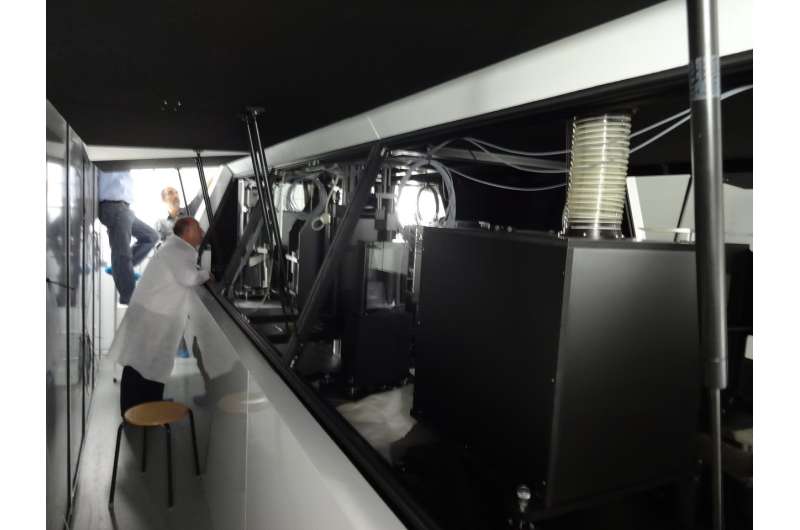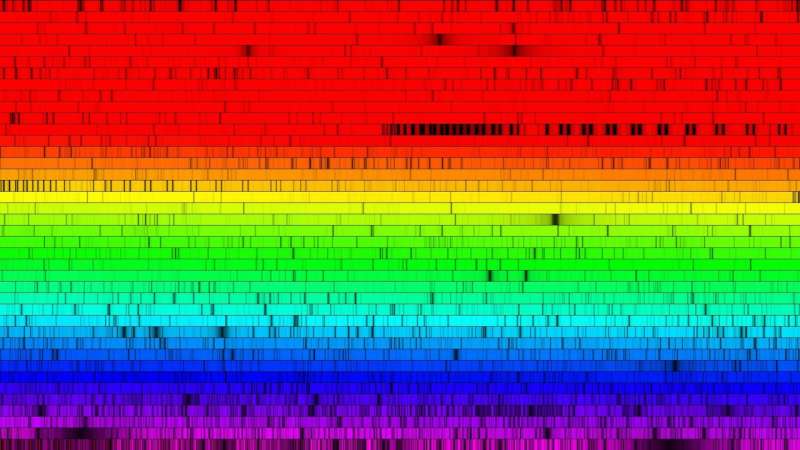First PEPSI data release

The Potsdam Echelle Polarimetric and Spectroscopic Instrument (PEPSI) at the Large Binocular Telescope (LBT) in Arizona released its first batch of high-spectral resolution data to the scientific community. In a series of three papers in the European journal Astronomy & Astrophysics, the PEPSI team presents a new spectral atlas of the sun, a total of 48 atlases of bright benchmark stars, and a detailed analysis of the chemical abundances of the 10-billion year old planet-system host Kepler-444.
Spectral atlases are the fingerprints of a star and give insights into almost all of its physical properties like temperature, pressure, velocities and chemical composition. The first paper contains a new spectral atlas of the sun and proves for the first time that a night-telescope instrument can reach a quality comparable to a specialized solar instrument. All solar and stellar spectra were taken with an unprecedented spectral resolution of l/Dl=250,000, a resolution equivalent to a 1/100th of the diameter of a hydrogen atom (l being the wavelength and Dl the smallest measurable separation of two wavelengths) and cover the entire optical and near-infrared light (from 383 to 914nm).
For the sun several spectral time series with up to 300 individual spectra per day were pre-analyzed and are also provided to the community. "These data recover the well-known solar 5-minute oscillation at a peak of 3 mHz (5.5min) from the disk-averaged light with a radial-velocity amplitude of only 47 cm/s, an incredibly small velocity from a stellar point of view," says Prof. Strassmeier, PEPSI principal investigator and director of the Cosmic Magnetic Field branch at the Leibniz Institute for Astrophysics Potsdam (AIP). The new atlas was also used to re-determine the abundance of Lithium in the sun with very high precision. "Lithium is a key element for the nucleosynthesis in the universe and is also a tracer of mixing processes inside stars," explains Dr. Matthias Steffen, one of the project scientists. Three-dimensional dynamic model atmospheres and a full statistical treatment of the spectral properties of the lithium atom were applied to determine the solar abundance.

The 48 stellar atlases in the second paper include the northern Gaia benchmark stars as well as other Morgan-Keenan standard stars. Spectra of these targets were not available at the given resolution and signal-to-noise ratio (S/N) before. The latter quantity represents the photon noise relative to the signal strength from the star and thus the quality of the spectra. Previously available S/N for work on astrophysical parameters was typically several hundred at a spectral resolution l/Dl of at most 100,000. "PEPSI and the LBT provide S/N of several thousand at on average three times higher spectral resolution," says Ilya Ilyin, PEPSI's project scientist. "With such numbers we have now the typical daytime solar-like spectrum quality available also for bright stars at night time," adds Strassmeier.
Finally, in the third paper, the star "Kepler-444," hosting five sub-terrestrial planets, was confirmed to be 10.5 billion years old, more than twice the age of our sun and just a little bit younger than the universe as a whole. The star is also found being poor on metals. The chemical abundance pattern from the PEPSI spectrum indicates an unusually small iron-core mass fraction of 24 percent for its planets if star and planets were formed together. For comparison, terrestrial planets in the solar system have typically a 30 percent iron-core mass fraction. "This indicates that planets around metal-poor host stars are less dense than rocky planets of comparable size around more metal-rich host stars like the sun," explains Claude "Trey" Mack, project scientist for the Kepler-444 observation.
More information: K. G. Strassmeier, I. Ilyin, and M. Steffen, PEPSI deep spectra. I. The Sun-as-a-star, A&A, in press; arXiv:1712.06960
K. G. Strassmeier, I. Ilyin, and M. Weber, PEPSI deep spectra. II. Gaia benchmark stars and other M-K standards, A&A, in press; arXiv:1712.06967
C. E. Mack III, K. G. Strassmeier, I. Ilyin, S. C. Schuler, F. Spada, and S. A. Barnes, PEPSI deep spectra. III. A chemical analysis of the ancient planet-host star Kepler-444, A&A, in press; arXiv:1712.06986
Journal information: Astronomy & Astrophysics
Provided by Leibniz-Institut für Astrophysik Potsdam (AIP)





















